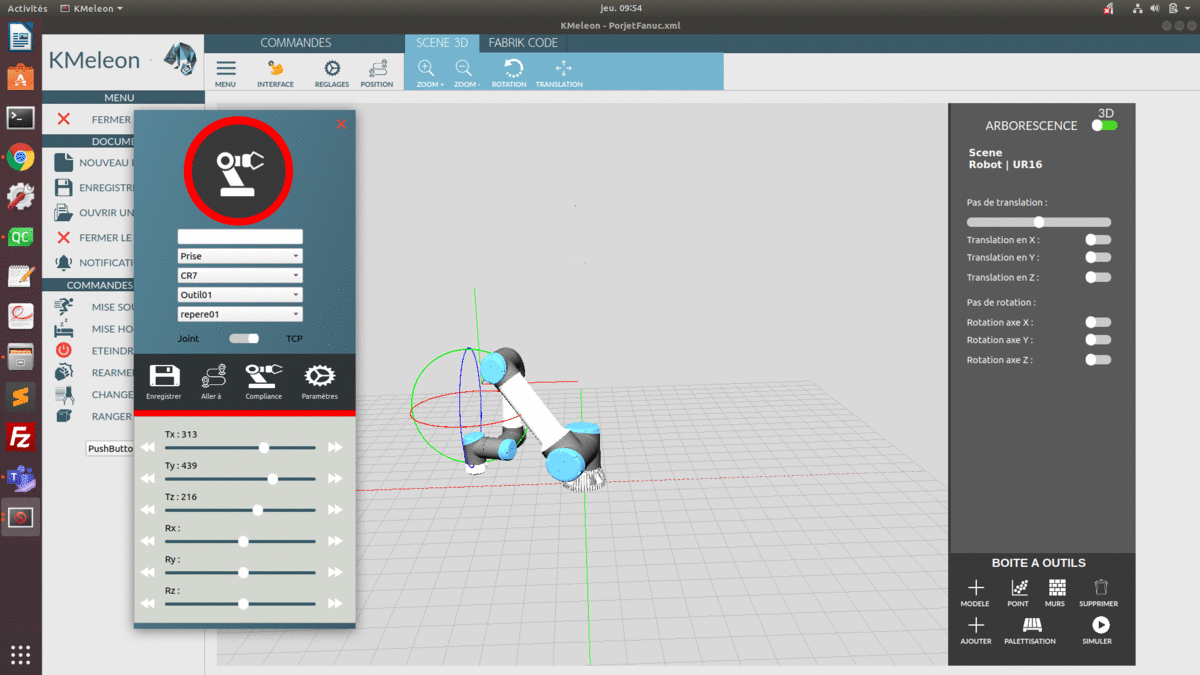RoboDK TwinTrack Alternatives & Competitors
Ranked Nr. 53 of 85 Robot Software

Top 10 TwinTrack Alternatives
- RoboDK RoboDK
- Tesseract Solutions KMeleon Software
- RoboDK TwinTool- Automated tool calibration for robots
- EZPhysics EZPhysics
- Cogmation Robotics Virtual Robotics Toolkit
- Robomatter Robot Virtual Worlds

RoboDK RoboDK
Offline programming | Simulation | Developer tools | VisionRoboDK is a comprehensive robotic simulation and programming software that offers a user-friendly experience with five easy steps to simulate and program robots. It provides access to an extensive library of over 500 industrial robot arms from various manufacturers like ABB, Fanuc, KUKA, and Universal Robots. Moreover, it supports external axes such as turntables and linear rails, allowing users to model and synchronize additional axes effortlessly.
The software facilitates precise tool definition by loading 3D models of tools and converting them to robot tools by drag-and-drop actions. Users can calibrate robot tools accurately using RoboDK. Additionally, it enables the loading of 3D models of parts and placing them in a reference frame for a quick proof of concept. The simulation capabilities enable users to create robot paths using an intuitive interface, integrating with CAD/CAM software and accessing plug-ins for various design software.
RoboDK's standout feature lies in its ability to generate robot programs offline with just two clicks, supporting over 40 robot manufacturers with more than 70 post-processors. It eliminates the need for programming experience, making it accessible to a broader user base. Furthermore, it automatically generates error-free paths, avoids singularities, axis limits, and collisions, ensuring efficient and collision-free robot programming. The software's capability to split long programs enables easy loading into the robot controller, streamlining the programming process for industrial automation tasks.

Tesseract Solutions KMeleon Software
Simulation- Set-up all of your line on a single software : robots, tools, controllers, sensors.
- Thanks to the technology FabrikCode, you'll be able to program without typing any line of code. Thanks to this technology based on "Drag & Drop" you'll gain more freedom.
- KMeleon gives you access to a universal language for the robotic programming of the main robot suppliers (Fanuc, ABB, Kuka, UR, Staubli…)
- Try your programs on KMeleon or on a robot, you'll choose ! Thanks to the 3D simulation interface you can simulate the different moves and measure your cycle time in no time.

RoboDK TwinTool- Automated tool calibration for robots
SimulationForget about manually calibrating your
robot.
- RoboDK TwinTool Features
Automated tool calibration (TCP)
- Calibrate spherical and conical tools
- Up to 0.250 mm accuracy
- Programming experience not required
- Automatic collision avoidance
- Support for over 700 robots
- Easily create your Digital Twin
- Supports multiple linear gage sensors
- Easy integration

EZPhysics EZPhysics
SimulationEditor & Simulator
- Facilitate the mapping between 3D meshes and physics engine objects for the purpose of mass/inertia and collision.
- Lets you interactively embed objects supported by the physics engine into 3D meshes, attach joints and constraints to the physics objects
- Save the “physically rigged” scenes into files, and run interactive simulations.
Remote control protocol
- Lets a remote "brain" control the robot/character through closed loop network protocol. EZPhysics sends the details of all the joint positions, collisions and disposition relative to the environment (IMU). The remote brain sends back commands to the robot/character's motors. The system allows finetuning and balancing the a fixed number frames per second vs. real-time performance.
- This makes it easier to develop complex controllers using Matlab or any programming language without needing to know anything about EZPhysics.
- This allows seamless transition to a real robot with same features as the simulated one (with an embedded computer and wireless interface) that can mimic the same protocol.
C++ API
- Lets you embed the “physically rigged” meshes into your 3D game or application. This involves using classes and methods for reading the rigged-models files and manipulating the physical aspects of the objects, such as applying torques and forces to joints. The API uses similar popular design patterns as Ogre.

Cogmation Robotics Virtual Robotics Toolkit
SimulationBuild
Bring your LDraw™ creations to life! The Virtual Robotics Toolkit has the ability to import files that are created using a number of free 3D modeling tools. Whether you are modeling using LEGO® Digital Designer™, MLCAD, or LDCad, simply import your model and prepare to be amazed. Within just a few short minutes you’ll be working with your own creation in a physics enabled simulation
Program
Then use the LEGO® MINDSTORMS® EV3 programming environment to write programs to control your virtual robot, just as you would the real thing. If you’re familiar with MINDSTORMS programming, you already know how to use our simulator. If you are new to LEGO® Robotics, don't worry, our training materials will turn you into a pro.
Simulate
The simulator's advanced physics engine affords an unparalleled level of realism. Experiment with how various physical forces act on your robot, change the friction on the playing surface, or mess with gravity to see how your robot would behave in a weightless environment.
Education With Simulation
Robotics is a great way to learn about programming, and an even more powerful tool for teaching STEM subjects.
Simulation is an effective means for understanding how physical concepts like force and motion come to play in real life.
No Robot, No Problem
Simulated robots are available 24 x 7, don't ever break, and are never missing parts.
With the Toolkit you can build and program your robot using the exact same tools you would use on the real thing — code you write for your simulated robot will also run in real-life.
Competitive Edge
The Toolkit makes it easy for your team to rapidly design and prototype your robot.
Why wait until your next meetup to see if your robot actually works? Import custom robot models from a variety of popular CAD tools such as LEGO® Digital Designer™ and begin experimenting instantly.
Analyze
See what your robot sees, visualize the sensor outputs in an easy to understand way. The Virtual Robotics Toolkit provides support for the following sensors:
- MINDSTORMS EV3 – Ultrasonic sensor
- MINDSTORMS EV3 – Color sensor
- MINDSTORMS EV3 – Touch sensor
- MINDSTORMS EV3 – IR sensor
- MINDSTORMS EV3 – Touch sensor
- EV3 Gyro Sensor
- HiTechnic – Infrared sensor
- HiTechnic – Compass sensor

Robomatter Robot Virtual Worlds
SimulationRobot Virtual Worlds is an advanced simulation software built around the powerful ROBOTC IDE. Users can program virtual LEGO Mindstorms NXT, EV3, VEX or TETRIX robots, either by using ROBOTC or visually via the Graphical Natural Language library extension, and observe their behavior in the 3D simulation environment which accurately renders these robots and their interactions. RVW was primarily designed as an educational tool however it is well suited for all levels of expertise – beginners can learn how to program these robots, teachers and students can use it for home or lab work, while advanced users can refine code or detect errors in their programming.
Several software extensions complement the feature set even further. For instance the Virtual Brick Emulator offers users a similar experience to that of programming an actual LEGO Mindstorms brick with NXT-G or LabVIEW. There are also extensions for creating custom levels, importing 3D models or measuring distances and trajectory angles around virtual environments.
RVW runs on Windows and is available in platform specific releasese. Free trial versions are available for download and licensing starts at US $49. There are also several apps available for iPad in which users can program VEX robots or play games with simulated robot behavior based on user programming.

